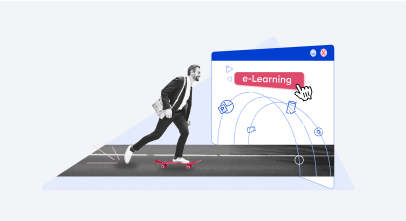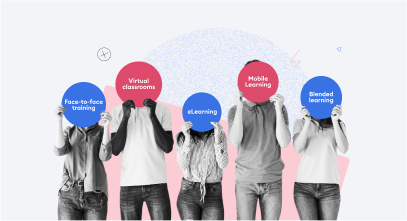Learning Retention: What Is It and How To Make Information Stick

It’s human nature to forget much of what we read, watch, think, and even learn hard to cement in our memory. While forgetting is not something that we can avoid, teachers and trainers constantly look for effective ways to help their learners remember information longer.
In this article, we’ll share valuable insights on how to develop training programs that will become learning retention boosters. But first, let’s discuss what learning retention entails.
What Is Learning Retention?
Learning retention is the ability to store new information in one’s long-term memory so a person can easily recall it and put that knowledge to use in the future. If the information is not retained, it will remain in the short-term memory and drop out after a certain period.
The fact is that the human brain forgets information very quickly. This was proved by the German psychologist Hermann Ebbinghaus, who is known for his discovery of the so-called Forgetting Curve. He explored the exponential nature of forgetting. Research shows that an average learner forgets 70% of what they learned within 24 hours and 90% of what they learned in a week if they don’t make an effort to retain it.
Here’s how information is forgotten over time:

Of course, it looks frustrating. After all, for businesses, it means that no matter how much money and time you invest in employee training, nearly everything will be forgotten. It’s like putting fuel into a car that has a hole in the tank — almost all your efforts are in vain.
But before you throw your hands up in dismay, know that you can change this! There are several methods you can use to help your learners combat the Forgetting Curve.
The Learning Retention Pyramid
The Learning Pyramid, also known as “the Cone of Learning” was developed by the National Training Laboratory. This model shows what types of study are most likely to be retained. It suggests that some teaching/learning strategies are more effective than others and that by using some of them, you can achieve longer-term retention.

As we can see in the picture, the pyramid shows how much people remember based on how they receive information. Let’s take a look at each level individually, working our way down the pyramid.
Lecture – 5%
According to the model, listening to a lecture is a passive way of learning and one of the most unproductive ways to retain information. However, you can make it more effective by incorporating other practices. For example, you can hold a discussion around the subject of your lecture or ask your learners to take notes. And keep in mind, we’re talking about the old pen-and-paper method and not digital note taking.
As research shows, students who practice taking notes by writing them out by hand not only retain more information, but also have a better understanding of the material being taught than those who record notes on digital devices.
Also read: The Ultimate Guide to Lecture Capture
Reading – 10%
Reading is considered more effective way than listening to a lecture, but still doesn’t yield much in terms of retaining information. Although reading textbooks is something that we used to do long ago at school, many of us still perceive it as a boring and tedious task. So, it’s the job of an instructor or an entire L&D department in a company to make reading materials easy to read and comprehend.
As with lectures, you can also suggest that your learners take notes while reading. Watch this video to find out about the “Summary and Action Sheets” method. It will definitely help your students remember more of what they read:
Audio-visual – 20%
The audio-visual method may include various kinds of learning aids: pictures, infographics, charts, videos, slide shows, whiteboards, and more. According to our model, it is still passive and can help learners retain 20% of the information provided. But with modern technologies, you can transform it into active or at least semi-active learning and significantly increase the retention rate. This is possible if you include interactivity in your training.
Example: You can ask your learners to look through an ordinary PowerPoint presentation that covers a specific topic, or transform it into an online course with branching scenarios, interactive quizzes, and role-plays. Which one do you think they’d like more?
Take a look at this online course to get an idea of how it works:
It’s made with iSpring Suite, a complete authoring solution that allows you to create versatile eLearning content: courses, quizzes, video lectures, role-plays, and more. The best thing is that it works as a PowerPoint add-in, so you don’t need any IT skills to produce the content. Once installed, the iSpring Suite tab will appear on the PPT ribbon. Just go to this tab to see the toolbar with all iSpring tools.

Demonstration – 30%
Demonstration typically involves an instructor who shows learners how to perform a task using a step-by-step approach. As they show “how,” they also “tell” what they are doing. The effectiveness of this method depends greatly upon how well a trainer explains the material, so providing accurate explanations and using clear language are a must. You can consider the demonstration to have been successful if your learners can do what they have been taught on their own.
However, if the process you’d like to show is quite tricky and hard to remember after having seen it only once, or if you teach your learners online, you can record a video of your demonstration and share it with your audience. That way, your learners will be able to rewatch the video as many times as needed.
With iSpring Suite, you can create demonstration videos yourself, with zero video production skills. To make your tutorials more vivid and engaging, add supportive visuals and captions. For example, outline the steps in the video as in the example below:

The demonstration method is especially effective if you want your employees to learn how to work with business software. iSpring Suite has all the necessary functionality for you to create watch-and-repeat software tutorials. Just record your screen, complement it with a voice-over or presenter video, and add a visual hint for each step so your learners can easily repeat your actions.

Group discussion – 50%
This is a form of cooperative learning and an active study strategy that can yield a 50% learning and memory retention. It stimulates student thinking, nudges learners to exchange their ideas, and increases participation and engagement. Besides, when people discuss a topic with peers, they have to listen to different opinions, pay attention to the facts they’ve missed during their study, and therefore dive deeper into the subject.
To get the most out of group discussions, you need to follow a few rules:
- Exhibit the behavior and attitudes you want your learners to acquire
- Encourage your learners to speak
- Use reassuring body language and tone of voice
- Be a good listener and give all students a chance to be heard
- Be supportive and provide positive feedback for joining the discussion
- Be careful regarding people’s feelings
Practice – 75%
“Practice makes perfect,” as the saying goes. And this is entirely true when it comes to learning. If you want to be a great pianist, you have to play the piano with dedication, right? And if you want to become a professional sales rep, you need to practice your sales skills a great deal.
As you can see from the example, hands-on learning is a perfect fit for employee training. Here are a few ways you might want to leverage it in your corporate environment:
Coaching/mentorship
This approach puts a team leader, supervisor, or manager in the role of coach or mentor. The coach/mentor will explain how to perform a specific task, then observe their trainee performing it, and provide constructive feedback.
The buddy system
This method pairs a trainee with a colleague at the same level, as opposed to a superior. The trainee observes how job tasks are performed by their peers in a real-world setting and repeats the actions.
Simulations
This training method doesn’t involve anyone except a learner. The trainee deals with a simulation that emulates an actual work environment. Their task is to perform their job duties as they have to in real life.
Some companies use AR and VR simulations for these purposes. For example, UPS uses VR technology as part of their training to teach driver safety. The simulation looks like a video game in which trainees need to spot hazards such as pedestrians, parked cars, and oncoming traffic; but it’s serious training.
Another type of training simulation that can help you improve your learning retention is a dialogue sim. Its development is not as pricey as the VR approach, but can be extremely helpful when training communication skills, including how to behave with customers, how to make a sales call, and how to speak persuasively. This is an interactive exercise that imitates a real conversation with a person and can be based on an actual business case. For example, the simulation below teaches bank employees to manage conversations, ask questions correctly, and overcome objections.
The best thing is that you don’t need special skills to create such dialogue simulations. iSpring Suite has all the necessary functionality for this and allows you to make them quickly and easily.
Teaching others – 90%
There’s another thing that helps when learning a new skill and that’s teaching it to others. According to the Learning Pyramid, it ensures an increase in knowledge retention by 90%, and this makes sense. If you can teach other people about your subject, it means that you understand it well and can easily recall it whenever you need to.
In a learning setting, this often takes the form of study groups or peer tutoring. You might also want to use other approaches to peer-to-peer learning. For example, you can create a private group on social media and ask your employees to share their insights and discuss recent information on ongoing projects. Or, like the British Telecom Dare2Share project, ask your employees to identify issues they face at work and record short videos that explain how they solved their problem.
More Tips on How To Improve Learning Retention
We’ve covered different learning strategies with the expected retention rate they can bring, and how to empower them to achieve even higher results. But, of course, there are some other factors that will definitely influence learning and retention. You can see at least some of them in this picture:

When we put these factors and the Learning Pyramid model together, we can deduce some more strategies that can help to facilitate knowledge retention and slow down the process of forgetting.
1. Use blended learning
To achieve better learning comprehension and retention, include various kinds of training. For example, use the flipped classroom approach: ask your learners to study all theoretical materials at their own pace and practice new knowledge during live sessions.
Or if you need to train your newly hired manufacturing machine operator, offer your newbie to read a manual on how to operate a machine, then ask your seasoned employee to show them how to do this in real life and let your new hire train their skills with a simulation. This allows your learners to go through the material several times, understand it in greater depth, and retain it better.
2. Use a mix of content types
If you use online learning methods, blend content types within your training program. For instance, you can start a program with an introductory video, then require a theoretical slide-based course, master the skills gained with a dialogue sim, and ask your learners to look through some additional reading resources on the topic.
By utilizing various learning styles and people’s senses, you’ll make your program much more memorable than if you just asked your learners to read a textbook.
3. Sell the “why” behind your training
If you’re going to train employees and have already created the best training in the world, it won’t matter if they don’t care. We’ve mentioned motivation and interest in the topic as important factors that influence learning and memory retention rate. And to pique employees’ interest and willingness to learn, you need to explain how the training will benefit them. Will it help them enhance their professional growth or move them closer to a promotion?
If your employees don’t know how training is going to change their lives or work, they won’t be motivated enough to retain new knowledge.
4. Leverage microlearning
You may have loads of valuable information to share with your learners, but, as the learning pyramid suggests, a long lecture is the least effective way to train. Nobody will be able to retain everything that’s provided in a lengthy session.
The far more effective approach to training is microlearning, which entails delivering information in small highly focused chunks. This is a perfect approach, especially if your employees study online in their free time. It will be much easier for them to retain knowledge by completing a single 10-minute learning module per day than if they were constantly distracted by their family members and household chores while watching a 2-hour webinar or taking a long comprehensive course in a single sitting.
5. Provide knowledge checks and assessments
According to recent studies, retrieval (the process of accessing specific information in your brain) is crucial for good learning. Every time a memory is retrieved, it becomes more accessible in the future. That’s why practicing memory retrieval has enormous potential for improving knowledge retention.
One great way to do this is to incorporate assessments into your training program. There are two types of assessments you might want to provide:
- Formative assessments. They occur within a course or lesson and are used to help learners revise or retrieve the material, identify areas where improvement is needed, and provide necessary assistance afterwards. For example, the learner can explain a topic in a more relatable and understandable way to the learner.
- Summative assessments. These occur at the end of training and serve as a final exam. Such assessments help trainers get accurate results on trainees’ comprehension after completing a course and evaluate their overall performance.
A traditional assessment tool is quizzes. With specific software like iSpring Suite, you can easily build quizzes on your computer and deliver them to your learners online. iSpring has ready-made templates of 14 different questions types: multiple-choice, true/false questions, fill-in-the-blanks, hotspots, sequences, and more. So, you can create your quizzes in a matter of minutes.
Here’s what a quiz built with iSpring Suite looks like:
FAQ
Here, you’ll find answers to some frequently asked questions about learning retention, and we’ll update this blog post with any new ones that you ask in the comment section.
What is the difference between learning, memory, and retention?
The relationship between learning, memory, and retention is incredibly close and intertwined. Learning means the process of acquiring new knowledge and skills, while memory relates to how the mind stores and recalls information. As for retention, it refers to storing information in the long-term memory so it can be used later.
How do people learn and recall information?
Recall is based on attention and thinking. First, we pay attention to a thing or some fact, then think it over, and make some considerations. That’s why the lower layers of the Learning Pyramid are more effective than the top ones – the bottom levels make learners reflect on the information.

How can the learning retention rate be measured?
A good way to see how your learners retain new knowledge is with the help of assessments. (we’ve already mentioned how you can create online quizzes). The best part is that you can deliver your quizzes with a learning management system (LMS) and track learners’ progress and results. LMSs typically have an entire set of reports that can help you evaluate your learners’ retention rate and overall performance.
Final Word
By applying the Learning Pyramid theory in your work, you can help your students and employees learn new information well and be able to recall it easily in the future. This model shows that some learning activities can have a greater impact on knowledge retention than others. But that doesn’t mean that lectures and reading assignments aren’t worthy of your attention, because they are supposed to bring little tangible benefit. All training methods are good if they are applied properly. So, follow the tips from our article, experiment, and seek out your own creative teaching solutions.
If you want to create eLearning content that will help your learners stay engaged, retain new knowledge easily, and apply what they learn in their life, download the iSpring Suite trial. This is a fully functional version of the authoring toolkit that will let you try out all its features for free for 14 days.















